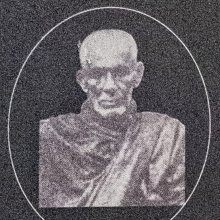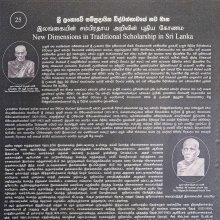Subhuti, Subhūti, Su-bhuti: 9 definitions
Introduction:
Subhuti means something in Buddhism, Pali, Hinduism, Sanskrit. If you want to know the exact meaning, history, etymology or English translation of this term then check out the descriptions on this page. Add your comment or reference to a book if you want to contribute to this summary article.
Images (photo gallery)
In Hinduism
Kavya (poetry)
Source: Wisdom Library: KathāsaritsāgaraSubhūti (सुभूति) is the son of Vasubhūti: the chief of a gang of robbers (caura-camūpati) from Sughoṣa, according to the Kathāsaritsāgara, chapter 73. Accordingly, as Padmiṣṭhā said to Śrīdarśana: “... and he [Vasubhūti] made me [Padmiṣṭhā] a prisoner and carried me off to his house, and he has made arrangements to give me in marriage to his son Subhūti. But his son has gone off somewhere to plunder a caravan, and, owing to my good fortune, the result of good deeds in a former birth, he has not yet returned; now it remains for Destiny to dispose of me”.
The Kathāsaritsāgara (‘ocean of streams of story’), mentioning Subhūti, is a famous Sanskrit epic story revolving around prince Naravāhanadatta and his quest to become the emperor of the vidyādharas (celestial beings). The work is said to have been an adaptation of Guṇāḍhya’s Bṛhatkathā consisting of 100,000 verses, which in turn is part of a larger work containing 700,000 verses.

Kavya (काव्य, kavya) refers to Sanskrit poetry, a popular ancient Indian tradition of literature. There have been many Sanskrit poets over the ages, hailing from ancient India and beyond. This topic includes mahakavya, or ‘epic poetry’ and natya, or ‘dramatic poetry’.
Shaktism (Shakta philosophy)
Source: Google Books: ManthanabhairavatantramSubhūti (सुभूति) (or Bhūti) and Sarveśvara refers to the pair of Goddess and God appearing in the eighth Kalpa (aeon), according to the Kularatnoddyota.—Chapter nine of the Kularatnoddyota opens with the goddess asking how the Kula tradition (kulāmnāya) will be worshipped along with its mantras and Vidyās and who will bring it down (avatāraka) into the world in the various cosmic aeons (kalpa). After explaining that it is brought down into the world by incarnations or aspects of both the god and the goddess (aṃśamātra), the god goes on to list the names of these aspects—a goddess and her consort [i.e., Subhūti—Sarveśvara]—in nineteen aeons (kalpa), many of which we recognize from the earlier version in the Tantrasadbhāva.—(cf. Jayadrathayāmala-tantra of the Kāpālikas).

Shakta (शाक्त, śākta) or Shaktism (śāktism) represents a tradition of Hinduism where the Goddess (Devi) is revered and worshipped. Shakta literature includes a range of scriptures, including various Agamas and Tantras, although its roots may be traced back to the Vedas.
In Buddhism
Mahayana (major branch of Buddhism)
Source: Wisdom Library: Maha Prajnaparamita SastraSubhūti (सुभूति) is the name of a disciple of the Buddha according to the 2nd century Mahāprajñāpāramitāśāstra (chapter XVI). Accordingly, “Among the Buddha’s disciples, Śāriputra is the first of the sages, and Subhūti is the first of those who have attained the concentration of tranquility”.
Also, “Furthermore, Subhūti excels in practicing the concentration of emptiness (śūnyatā-samādhi). Having spent the summer retreat (varṣa) among the Tao li (Trāyastriṇśa) gods, the Buddha came down into Jambudvīpa”.

Mahayana (महायान, mahāyāna) is a major branch of Buddhism focusing on the path of a Bodhisattva (spiritual aspirants/ enlightened beings). Extant literature is vast and primarely composed in the Sanskrit language. There are many sūtras of which some of the earliest are the various Prajñāpāramitā sūtras.
Tibetan Buddhism (Vajrayana or tantric Buddhism)
Source: Wisdom Library: Tibetan BuddhismSubhūti (सुभूति) is the name of a Śrāvaka mentioned as attending the teachings in the 6th century Mañjuśrīmūlakalpa: one of the largest Kriyā Tantras devoted to Mañjuśrī (the Bodhisattva of wisdom) representing an encyclopedia of knowledge primarily concerned with ritualistic elements in Buddhism. The teachings in this text originate from Mañjuśrī and were taught to and by Buddha Śākyamuni in the presence of a large audience (including Subhūti).

Tibetan Buddhism includes schools such as Nyingma, Kadampa, Kagyu and Gelug. Their primary canon of literature is divided in two broad categories: The Kangyur, which consists of Buddha’s words, and the Tengyur, which includes commentaries from various sources. Esotericism and tantra techniques (vajrayāna) are collected indepently.
Languages of India and abroad
Sanskrit dictionary
Source: DDSA: The practical Sanskrit-English dictionarySubhūti (सुभूति).—
1) well-being, welfare.
2) the Tittira bird; Gīrvāṇa.
Derivable forms: subhūtiḥ (सुभूतिः).
Subhūti is a Sanskrit compound consisting of the terms su and bhūti (भूति).
Source: Cologne Digital Sanskrit Dictionaries: Edgerton Buddhist Hybrid Sanskrit DictionarySubhūti (सुभूति).—(1) name of a Śākya of Devaḍaha, father of Māyā: Mahāvastu i.355.15; 356.5; ii.18.7; (2) (= Pali id., a thera) name of a disciple of Buddha, a sthavira: Mahāvyutpatti 1035; Saddharmapuṇḍarīka 2.7; 100.1; 146.13; 148.5; 149.6; Lalitavistara 1.17; Divyāvadāna 361.19; Sukhāvatīvyūha 2.9; the Subhūti of Avadāna-śataka chapter 91, ii.128.3 ff., has a story showing little resemblance to the Pali story of Subhūti, but both are entitled ‘chief of disciples that are araṇāvihārin (see araṇa)’, or in Pali araṇa°; Vajracchedikā 19.14 etc. 26.17; Su° is also first of dākṣiṇeya disciples, Karmavibhaṅga (and Karmavibhaṅgopadeśa) 161.18, as also in Pali of dakkhiṇeyya (in Aṅguttaranikāya (Pali) i.24.8—9 both titles are given him); the same as the Pali personage is doubtless meant also in Kāśyapa Parivarta 141.1 ff.; and Śikṣāsamuccaya 146.8 (from Dharmasaṃgīti-sūtra) and, all from the Bhagavatī, q.v., Śikṣāsamuccaya 202.8; 210.3 (= Śatasāhasrikā-prajñāpāramitā 1430.5); 262.12; (3) name of a Bodhisattva (compare Subhūmi): (Ārya-)Mañjuśrīmūlakalpa 461.6; (4) name of a kalpa: Gaṇḍavyūha 446.23.
Source: Cologne Digital Sanskrit Dictionaries: Cappeller Sanskrit-English DictionarySubhūti (सुभूति).—[feminine] welfare, happiness.
Source: Cologne Digital Sanskrit Dictionaries: Monier-Williams Sanskrit-English Dictionary1) Subhūti (सुभूति):—[=su-bhūti] [from su > su-pakva] f. (su-) well-being, welfare
2) [v.s. ...] m. Name of a lexicographer (also called -candra; he wrote a [commentator or commentary] on the Amara-koṣa)
3) [v.s. ...] of a Brāhman (son of Vasu-bhūti), [Kathāsaritsāgara]
4) [v.s. ...] of a teacher, [Buddhist literature]
[Sanskrit to German]
Sanskrit, also spelled संस्कृतम् (saṃskṛtam), is an ancient language of India commonly seen as the grandmother of the Indo-European language family (even English!). Closely allied with Prakrit and Pali, Sanskrit is more exhaustive in both grammar and terms and has the most extensive collection of literature in the world, greatly surpassing its sister-languages Greek and Latin.
See also (Relevant definitions)
Partial matches: Bhuti, Cu, Shu.
Starts with: Subhuti Sutta, Subhuticandra, Subhutika, Subhutipala.
Query error!
Full-text (+28): Subhutipala, Subhuti Sutta, Bhuti, Arana, Devakunda, Subhuticandra, Subhumi, Utpalavarna, Shashiketu, Pragriva, First Buddhist Council, Riddha, Sarveshvara, Rallaka, Ruta, Rutajnana, Ten Great Disciples, Jhallari, Sabhuti, Matriceta.
Relevant text
Search found 56 books and stories containing Subhuti, Subhūti, Su-bhuti, Su-bhūti; (plurals include: Subhutis, Subhūtis, bhutis, bhūtis). You can also click to the full overview containing English textual excerpts. Below are direct links for the most relevant articles:
Maha Prajnaparamita Sastra (by Gelongma Karma Migme Chödrön)
Chapter XX - (2nd series): Setting out on the Mahāyāna
Appendix 6 - Prajñā or Prajñāpāramitā as ‘the Mother of the Buddhas’ < [Chapter LII - Elimination of the Triple Poison]
Part 3 - Conversion of Śāriputra and Maudgalyāyana < [Chapter XVI - The Story of Śāriputra]
Studies in Indian Literary History (by P. K. God)
33,34. Subhuticandra’s Commentary on the Amarakosa < [Volume 1 (1945)]
59. Chronology of the Commentators of the Mahabharata < [Volume 1 (1945)]
Subject-Index (of first volume) < [Volume 1 (1945)]
Maha Buddhavamsa—The Great Chronicle of Buddhas (by Ven. Mingun Sayadaw)
Biography (13): Subhuti Mahāthera < [Chapter 43 - Forty-one Arahat-Mahatheras and their Respective Etadagga titles]
Part 4 - Contemplation of the Buddha (Buddhānussati Bhāvanā) < [Chapter 42 - The Dhamma Ratanā]
Notices of Sanskrit Manuscripts (by Rajendralala Mitra)
Vajracchedikā Prajñāpāramitā Sūtra
The View From the Center (by Ajahn Amaro)

